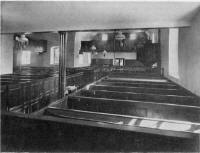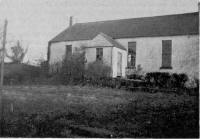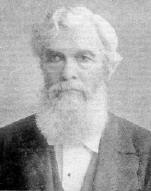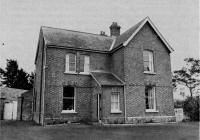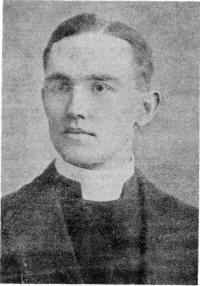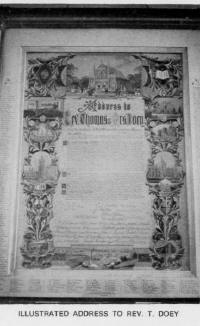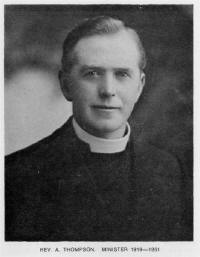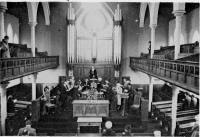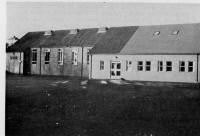|
||||||||||||||||||||||||||||
In 1856 Mr. Jackson Smyth was ordained as an assistant and successor to Mr. Collins. He remained until 1859 when he was called to First Armagh and went on to become well known throughout the Church.
At this point, we may note that `the year of grace' began in 1859 in
Ulster. Beginning in Ahoghill and Connor, revival came to many parts
of the land. Churches and the community generally were changed by the
Spirit of God. There are very few references to the effect of the
revival in Dromore. However, some statistical returns, noted in the
book, `The Year of Grace,' indicate that there were at this time 8
prayer meetings in connection with the church, and that the average
attendance at communion increased by 100. Evidently, the Lord did not
forget this part of the land, and his saving grace was extended to
members of the congregation. JAMES KIRKER STRAINIn 1860, Mr. James Kirker Strain was ordained in the Church as assistant and he became the Minister in full charge after the death of the Rev. Collins in 1863. There now began in this ministry a settled period of some fifty years, and during it a great affection developed between Minister and people. J. K. Strain was a son of the Manse in Cremore. Like his father, Rev. Dr. Strain, he had an academic turn of mind, and early distinguished himself as a scholar. He attended Queen's University, Belfast, and scored notable successes in the mental science group, obtaining the senior school in 1858, the year he graduated. He pursued legal studies together with an arts course, obtaining junior and senior scholarships in his Alma Mater. His theological education was completed at Assembly's College, Belfast, and he was licensed by the Presbytery of Belfast in December. During his years as Minister of First Dromore, Mr. Strain undertook further study and obtained his LL.B. and LL.D. (1885). Since it appears he took little part in the wider work of the Church, the congregation benefited from his studies through his pulpit ministrations. He married a daughter of the Rev. Greer of Annahilt, and one of their sons became a licentiate of the Presbytery of Dromore. A photograph of Dr. Strain, kept in the Minister's room, shows him to be a man of the old Presbyterian school. His bearded face, intelligent eyes, and strong dignified bearing, are the marks of one who laboured steadily in spite of a large share of suffering. The Banbridge Chronicle tells us that he never really enjoyed great health . . . `he was too keen and continuous a student and many a time the lamp of life flickered feebly enough.' This was no exaggeration, as the presbytery minutes show. Twice he wrote to the presbytery advising them of his ill-health. The first time was in November 1880 when he sought the advice of the presbytery as to his resignation from active duty as he felt unable to do all required of him. On this occasion the presbytery undertook to supply his pulpit. Then he wrote again in 1881 asking the presbytery to recommend to the Assembly he be allowed to resign if he found it necessary. He never did, and continued to minister until his death in 1907. Dr. Strain was a shrewd observer of life. He studied not only books, but also people. In the late 1860's he undertook a voyage to America and did some travelling there. On his return he gave a public lecture on his experiences and later published this in booklet form. From this it is evident that he had an eye for detail, and his gifted mind and keen insight enabled him to read a person's character accurately. In addition, he had a delightful sense of humour. These qualities are illustrated in the following incidents he relates in the booklet . . . On board the ship crossing to America he writes one Monday evening in the public lounge; `Let me look around and tell you what the folks are doing just now. Nearly opposite to me .... are two farmers, one Canadian, the other American, and they have set themselves to guess the professions of the different passengers. they thought themselves the only two farmers in the ship, and set down the most of the others as tailors, cooks, mechanics, etc. They could not guess what I was, so I had to tell them; when one of them said he strongly suspected it, as if in were something to be ashamed of. I told him I was not ashamed of it at all, when his friend said it was a calling honourable enough. Dollars and cents, rather then faith and good works, gold rather then Gospel, seems to epitomise their religion'. Dr. Strain was also a careful and gifted preacher of the Scripture, seeking to explain and to apply Reformed Doctrine. The Minutes of the General Assembly for 1908 refer to him as . . `A preacher of great merit, a diligent student, a high-minded Christian and a faithful friend'. Here is a man who preached with a Pastor's heart. He himself suffered both physically and emotionally through the loss of loved - ones (his daughter Lizzie died suddenly in 1897 aged 16), and he sought to apply the balm of the Gospel to the wounds of his people. Then, too, we find a man who loved his Saviour. Not that he was demonstrative in his faith; it burned quietly, but steadily and strongly. Here is an extract from one of his sermons, illustrating such qualities. The text is John ch. 13 verse 1, . .. `When Jesus knew His hour was come'. ...... Now my friends it is not Ministers
who are specifically set apart to spend their time and their life in
His dear service, who are called His own'. "This honour have all the
saints". You are His own, if you believe in Him if you live in a
garret. You are Christ's own, if you only repair a road or sweep a
street. You are His own, who believe in His Name, though every day you
stand behind a counter, or plough in the fields, or make the hay when
the sun is shining. I trust there are some of Christ's here today,
though they do not know it. Eought with his blood and they are well
aware of it. Chosen from all eternity, and yet they have not
discovered it. May God reveal to you His everlasting love, and enable
you to make your calling and election sure . . .' IMPROVEMENTS ARE MADEIt was during this century that a Church, and Manse fund was begun
throughout the Church, and at the visitation of 1863, the presbytery
asked the Committee of First Dromore to consider erecting a Manse for
the use of the Minister and his family. Therefore it would appear that
previous to this the Minister had to provide his own accommodation, or
it was rented for him. On the Rev. Collin's grave in the Church
graveyard, the Minister's address is given as Parkrow House. This is a
large house set in its own grounds approximately 200 yards behind the
present Manse, and it is still inhabited. Possibly Mr. Collins owned
it himself, or it was rented for him by the congregation. Nothing was
done about this recommendation for a few years, and there is reference
to this in the visitation of 1871. However, by the time of a further
visitation in 1878, the Manse had been built on the Dromara Road, and
this is the house which is occupied by the present Minister and his
family. Set in its own grounds, and surrounded by five acres of glebe,
it affords a fine view of the town and countryside. The Meeting-House too was improved during this period. Up to this time, access to the galleries of the building had been gained by way of outside stone staircases. These were removed, porches were built, and new safety staircases were installed. The roof which had previously been thatched, was slated. A central heating system was installed in the Church in 1895, and it was the job of the new sexton, Todd Barr, to see that this was kept in working order, and the Church properly heated for the Sabbath Services. Services regularly lasted two hours and often would not be finished until 2.00 p.m. The road, say old members, was black with people from 11.30 a.m. making their way to Church. The more wealthy members came by pony and trap, but many came on foot, often walking several miles on the journey to Church and home again. The evening service is quite a recent introduction. There is a reference in the Committee Minute Book of services being held in the school-room in 1902, because there was no lighting in the Church. The life of the congregation continued quietly. As we have seen, the Sunday School carried on a good work among the young, and Dr. Strain was kept busy with visitation and the superintendance of the eight or more Sunday Schools which met in the outlying areas of the parish. Also, he was involved in the oversight of at least three of the twelve day schools in the district, and attendance at the weekly prayer meeting. By 1907 Dr. Strain's health
was failing, and an assistant was appointed to help him in his duties.
He died in December. He was seventy years of age, and he had spent
nearly fifty of those years in the Ministry. On looking back over that
time it is clear that, had his health permitted, th Church might have
heard much more of Rev. Dr. J. K. Strain, and been the richer for a
wider service from him. CHAPTER 7THE OLD MAKES WAY FOR THE NEW
|
||||||||||||||||||||||||||||
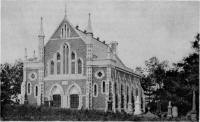 |
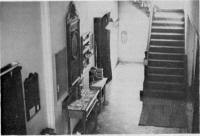 |
| FIRST DROMORE PRESBYTERIAN CHURCH
(TAKEN AROUND 1915-1917). |
VESTIBULE OF THE PRESENT CHURCH BUILDING |
Top
CHAPTER 8
WORSHIP, WITNESS and WORK
1918 - 1951
In September 1918 the Session and Committee were requested to release Mr. Doey for chaplaincy work with the soldiers in France. This was unanimously agreed. He and his wife were presented with an illuminated address, which today hangs in the Choir Room at the back of the Church.
(I have already referred to the effort which Mr. Doey put in to the rebuilding of the Church. Just how much his work was appreciated can be gauged from the following quotation from that address . . . `The most striking example of your labours has been the erection of our new and beautiful Church which by the blessing of God will stand for many generations as a memorial to your work of faith and labour of love in our midst. Although sorry to part with the old building so dear to our hearts with all its hallowed memories and sacred associations yet we felt that a more suitable place of worship was necessary. We were deterred however by the greatness of -the financial responsibility involved, but your wise and comprehensive plan which you demonstrated so clearly to us enabled us to see how the work could be accomplished and also won our confidence in your ability to carry it to a successful termination . . . It is impossible in a short address to do more than to refer to the great amount of work which you accomplished in connection with the building, but you carried it out in a zealous and very whole hearted manner not sparing yourself in any way where the interests of the Church were concerned. This great undertaking required a large amount of your time and yet you did not neglect the higher interests of the congregation as you ministered to them in spiritual things from Sabbath to Sabbath).
A short time later, Mr. Doey was called to the charge of New Row Coleraine, where he exercised a much appreciated ministry until his retirement in 1948.
A short vacancy followed in Dromore, until a call was made out in
favour of the Rev. Andrew Thompson. Mr. Thompson was the son of Mr. &
Mrs. John Thompson of Broughshane. He was
educated at Ballymena Model School and Ballymena Academy. His College
course was spent at Queen's College, Cork, and at Q.U.B. where he
studied mental science. This he followed with a course in theology at
Assembly's College, Belfast. He was licensed by the Presbytery of
Ballymena in May 1909 and installed in September in the congregations
of Tobermore and Knockloughrim. After 9�
years in Tobermore, he was called to First Dromore, and took up
residence in the Manse with his wife and two sons (Andrew and John,
who became doctors).
Mr. Thompson brought many happy gifts to his ministry in Dromore. He showed an inborn sense of tact in his handling of Session and Committee meetings, and his eminent good sense was commented upon by parishioners and pastors alike. These gifts he exercised in wider ministries, being Moderator of Presbytery, and elected Moderator of the Synod of Belfast. To his people he showed a generous heart, and the Manse door was ever open to the needs of many, rich and poor alike. In the pulpit he displayed a thoroughness of preparation, and an enviable command of the English language and knowledge of Literature. He was interested in the young people, and he and his wife developed close ties with the Girls' Auxiliary and the Boys' Auxiliary. With Mr. Thompson's encouragement, one of these young people, Alfred Martin, went on to become a Minister of the Presbyterian Church. In later years Dr. Martin lost no opportunity of speaking of the debt he owed to the Rev. A. Thompson, who was a spiritual father to him. Speaking in 1969 at the dedication of a memorial tablet and furnishings in remembrance of Mr. Thompson he said "that without his inspiration, encouragement and practical help so freely and gladly given, my life must have been altogether different."
By means of this work they helped train a generation of people with a
strong sense of loyalty to the Church. On his retirement, it is
evident that the congregation deeply appreciated the humanity which
had been shown them in many ways over the years.
During these years the life of the congregation was extended. The
prayer life of 'the people continued in district prayer meetings,
faithfully presenting the needs of the Church to the Almighty, in
fellowship. There were also two district Sunday Schools. In 1921, the
attendance at the morning worship was 510.
Top
At this time attitudes to
the musical ministry of the Church were beginning to change.
Previously, only Psalms had been sung, unaccompanied. A Precentor,
(for many years Schoolmaster McAlister) led the singing. I have
referred above to the use of a piano at an earlier date, and the
objections raised. However, with the passage of time, these feelings
were overcome, and changes were made. In October 1921 it was agreed to
use instrumental music at the Monday evening Harvest Service. Then, at
a congregational meeting in September 1924, it was agreed to use such
accompaniment at all the services in future. Later on in 1935-1936, a
pipe organ was installed. The new organ was built by Messrs. Evans and
Barr, Belfast. It is a two manual and pedal instrument of 27 stops and
17 accessories. The casing is American Oak, and the whole cost just
over �l100 to install. This organ is still in use, and has been
favourably remarked upon by many organists. It was under the special
care of Mr. Samuel Wethers from 1949, in which year he was appointed
as organist and choirmaster. Known over a wide area of countryside as
a music
teacher, Mr. Wethers faithfully served the congregation until his
sudden death in April 1980. During these years he gave generously of
his time and his talent to train the generations in the praises of the
Lord, and to lead the worship reverently each Sunday. Seldom was he
absent from the organ consul or from his beloved choir.
W. P. NICHOLSON COMES TO DROMORE
During the 1920's the Rev. W. P. Nicholson was becoming well-known in Ulster, and further afield, and interest was expressed in Dromore for bringing him to preach here. A United Committee was set up in the town, and the use of First Dromore building for the Services was requested. This was granted, and the Services were held from 4th June to 2nd July 1922. The stipulation was made that there would be no instrumental music. Leading up to, and during the Mission, united prayer meetings were held weekly in the two Presbyterian, the Episcopal, and the Methodist Churches, where `the Lord's people poured out their hearts for a revival of the work of God in Dromore and vicinity.'
The Alexander hymn book was used in the Services, and people crowded into the meetings from miles around. Often Mr. Nicholson would preach for an hour and a quarter, on such subjects as . . . `The Life that burns and Shines' . . . `Hell' . . . `The Unpardonable Sin' . . . `How do I know that I am saved.' Says the Leader . . . `Mr. Nicholson preached with all the intensity and moral indignation of the Old Testament prophets. He denounced all sins and shams, and yet he is so tender and human, and the wooing note is so manifest that he captures the mind and heart and conscience of his hearers.'
Such a ministry could not but bring blessing to many lives, and so it was. Many people professed conversion, and a great work was done. A Christian Endeavour Society in connection with First Dromore and Banbridge Road congregations was established to help the new converts grow and mature in their faith. This continued for some years.
It is always a healthy thing for a congregation to look beyond its own interests, and this is probably most effectively done when one of its members becomes involved in a wider work. In November 1924, Mr. T. J. Martin, son of Mr. Augustus Martin, was ordained to the Ministry in First Dromore. He had plans to go to the Mission Field, and after his ordination he travelled to China, and worked in Manchuria until 1929, when he returned to minister in England.
Toward the close of his ministry, Mr. Thompson was dogged by ill-health, and he sought assistance in the parish work. He found this in Mr. D. H. S. Armstrong, who was later ordained for special work with Scripture Union in Northern Ireland. Mr. Thompson's days of active ministry were obviously drawing to a close, and he retired in November 1951. He moved to Larne where he and his wife lived until their deaths in 1968 and 1974 respectively.

